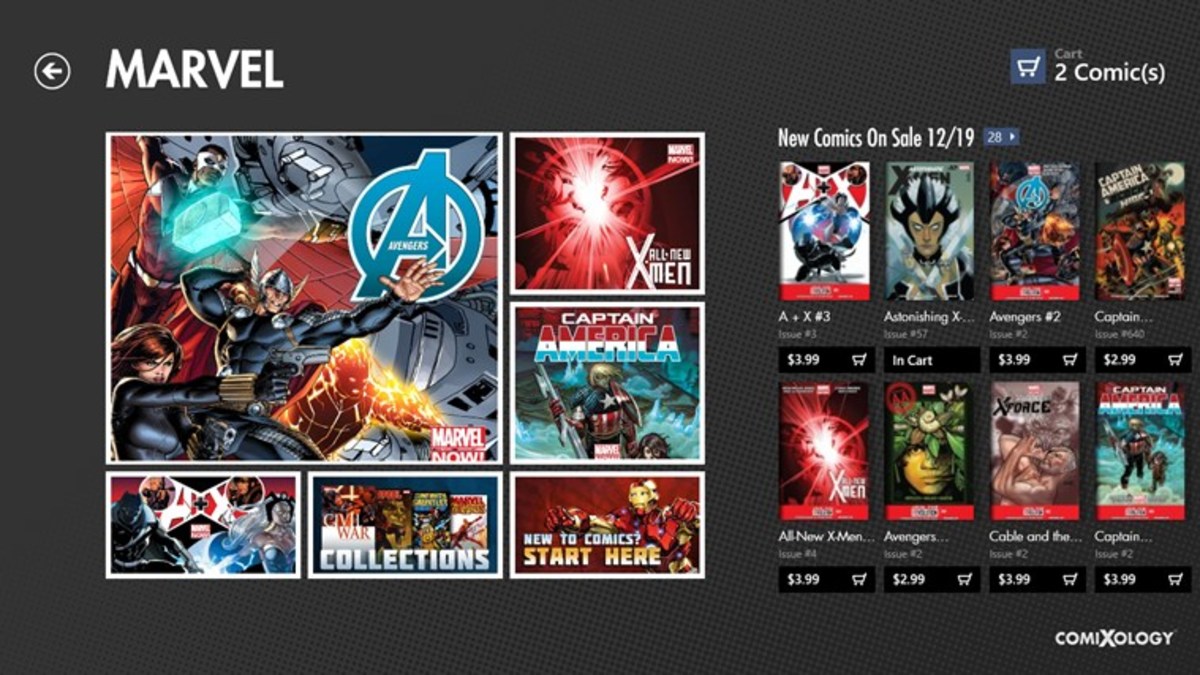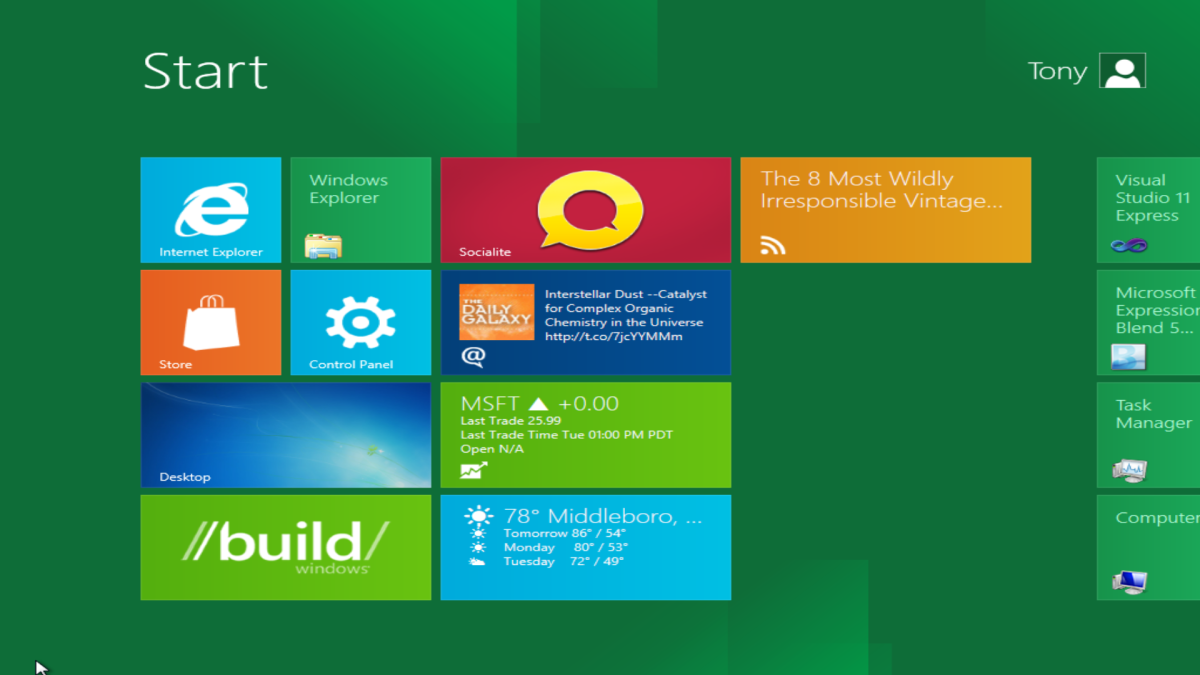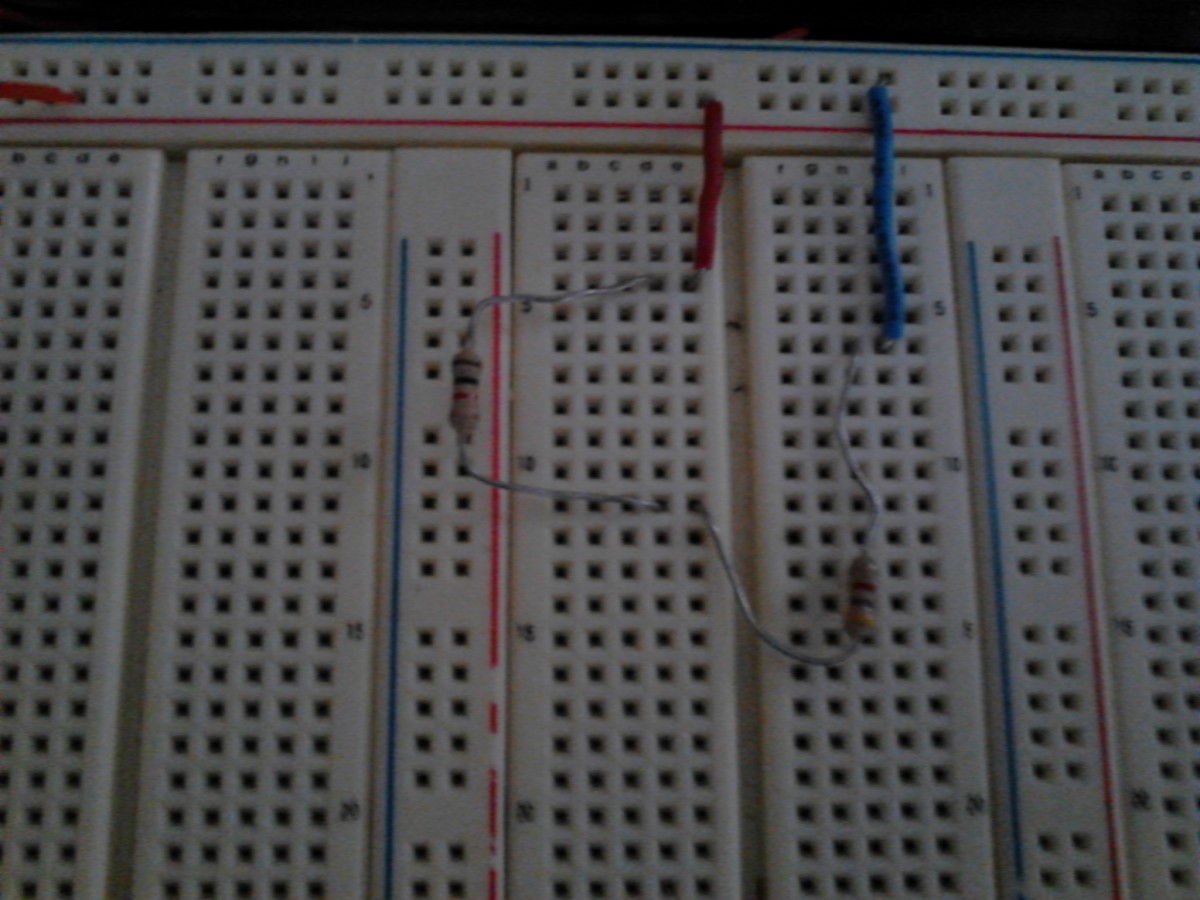Review: Intel Next Unit of Computing (NUC) Kit DC3217IYE
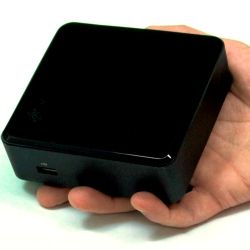
What is the Intel NUC Kit?
The Intel Next Unit of Computing or NUC Kit is a DIY computer kit that comes in a tiny form factor that is roughly 4" x 4" x 1.5" and it is powered by a 3rd generation Intel® Core i3- 3217U processor. It is considered a DIY kit because it is missing 3 critical components, a hard disk, memory and an operating system.
There are two versions of the NUC Kit that is currently available. The first is the DC3217IYE model which comes with 2 HDMI ports and Gigabit Ethernet while the DC3217BY model comes with 1 HDMI port and a Thunderbolt port. The only other difference between the 2 models is that the Gigabit LAN model comes with a black chassis while the Thunderbolt has a maroon chassis.
The Thunderbolt interface combines PCI Express (PCIe), DisplayPort (DP) and power into a single port. A single Thunderbolt port can support up to 6 Thunderbolt devices using a hub or just daisy chain them together.
According to the Intel NUC product brochure, the product is aimed towards digital signage, home entertainment and portable uses. I'm primarily looking at the NUC as a home theater PC in this review and I think most people will be interested at this aspect as well. I will also be checking the NUC's capability as a gaming machine. I know that the NUC is not a gaming powerhouse by far but we don't all need state of the art PCs to get a little gaming fun out of our PCs.
Last but not least, the Intel NUC Kit version that I am reviewing is the DC3217IYE with the Gigabit Ethernet.
All images courtesy of Roy Yap and Amazon
Intel Next Unit of Computing Kit

Unboxing the Intel NUC Kit DC3217IYE

The Intel NUC DC3217IYE comes in a box that is about one and a half times the size of the NUC unit itself. The really cool thing about the packaging is that when you open the box, it plays the familiar Intel 5 note jingle. It is light activated. Think of it as a modern version of the musical greeting card.
Inside the box is the NUC unit, a VESA bracket plus the required screws for mounting the NUC behind a monitor if you so wish, a power adapter and a quick start guide. Strangely, the power adapter brick does not come with the AC power cord itself that is required to connect the brick to the wall socket. The power adapter does not use a standard PC power cord but one of those "Mickey Mouse" cords with the triangular circles.
As stated on the box itself, besides the AC power cord, you need to supply the SO-DIMM memory, an mSATA drive and a wireless module if you require WiFi support. The other important missing element is the OS itself.
My first impression of the NUC device is that it looks good and the build quality is excellent. The DC3217IYE comes in all black. There is a single USB 2.0 port on the front of the unit while on the top surface, there is a lighted power button located on the lower left corner and right next to it is the hard disk activity indicator light.
There are no buttons or ports on either sides of the NUC. All the other ports are located at the rear end. From left to right are the power port, another 2 USB 2.0 ports, 2 HDMI female ports and a Gigabit LAN port. Also located at the rear are a couple of exhaust vents and interestingly enough, a Kensington Security Slot or K-Slot.
At the bottom of the unit are more venting holes. These are used by the cooling fan to suck in cool air from the bottom of the unit so make sure that these vents are not blocked by a thick carpet for example.
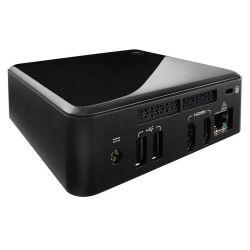
Intel NUC Kit DC3217IYE specifications
The Intel NUC device uses the Next Unit of Computing Board D33217GKE that is powered by a 3rd generation Intel Core i3 - 3217U processor on the Intel QS77 Express Chipset. The Core i3 processor is soldered on the board itself with an active heatsink and therefore it is not swap-able.
Intel categorizes the new D33217GKE motherboard form factor as UCFF (Ultra Compact Form Factor) that has a max dimension of 4" x 4" x 2". This is significantly smaller than the popular Mini ITX 6.7" x 6.7" form factor that most small form computers are based on.
The D33217GKE board features dual HDMI ports supporting HDMI 1.4a to support 2 displays at the same time and also 8-channel (7.1) digital audio. There is a cooling fan but the noise generated is minimal.
It also has 5 USB 2.0 ports but only 3 are made available on the NUC. It is unfortunate that USB 3.0 is not supported. There is no built in WiFi but WiFi can be supported by adding a WiFi module on the board itself. Alternatively, a USB WiFi dongle can be used as well. Network support is via Gigabit LAN. My unit did not come with the optional WiFi module so the network connection is via wired LAN only.
There is no built in Bluetooth connectivity but again it can be added by using a USB Bluetooth dongle.
The board features two SO-DIMM connectors to support up to 16GB of RAM and two PCIe mini-care connectors for mSATA SSD and wireless module support. One of the PCIe connector is full sized while the other is half sized.
INTEL NUC KIT DC3217IYE SPECIFICATIONS
- Chipset - Intel QS77 Express Chipset
- Form Factor - UCFF (Ultra Compact Form Factor)
- Processor - Intel Core i3 3217-U
- Memory - Two SO-DIMM slots for 1333/1600 MHz memory support
- Video Output - Dual HDMI ports supporting HDMI 1.4a
- Audio Output - 8-channel (7.1) digital audio via two HDMI 1.4a outputs
- Network - Gigabit LAN
- USB Ports - 3 USB 2.0
- Expansion capability - Full size mini PCI Express with mSATA support. Half size mini PCI Express
- Size - 4.5" x 4.4" x 1.5"
- Weight - 18 oz
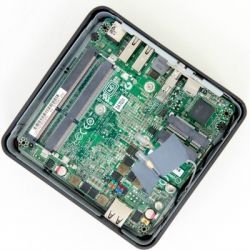
Setting up the Intel NUC Kit DC3217IYE
With its neat looking packaging, it is easy to forget that like its name suggests, the NUC Kit is not a complete product and you do need a few essential add-ons, namely the RAM, hard disk and operating system. This means that you need to get your hands dirty and get into the innards of the NUC to do some hardware installation followed by further waiting as you install the operating system. This is definitely not the product for those who are impatient.
Fortunately, the hardware installation part is actually much easier than it sounds. The toughest part is actually figuring out which components to use.
For RAM, the NUC uses SO-DIMM, or small outline dual in-line memory module. SO-DIMMs are half sized versions of regular DIMMs and are usually used in notebooks and other small form computers. Intel has provided a list of compatible SO-DIMMs that have been tested with the NUC on their website. For my NUC, I've decided to go with a single piece 8GB SO-DIMM so that I still have the option to max out to 16GB if I so wish.
Next is the storage. The D33217GKE board on the NUC supports Mini-SATA or mSATA Solid State Drives (SSD) natively. I went with the Crucial m4 mSATA 128GB internal SSD which is a good balance between price and storage space.
Installing both the SO-DIMMs and the SSD requires opening up the NUC. Just turn the NUC upside down and remove the 4 Phillip screws at the rubber feet. With the front single USB port facing you, the two SO-DIMM slots are located on the left side while the two PCIe slots are on the right.
To install the memory, just place the SO-DIMM into the slot and then push it down to lock it in place.
To install the SSD, I used the full sized PCIe slot located at the top (the bottom slot is the half sized slot). Just insert it in at an angle and then lock it into place using a single screw. If you plan to add WiFi support, the WiFi module would be placed in the half sized PCIe slot at the bottom. You also need to attach the leads to the WiFi antenna to the module itself.
This is all you need to do as far as hardware installation is concerned. Just close the bottom cover and you are done.
Compared to the hardware installation, the software installation is actually more work and definitely took much longer. I have decided to go with a Windows 8 Pro installation on the NUC. I purchased a copy of Windows 8 Pro online and then proceeded to create a Win 8 Pro USB installation flash disk with the tools provided by Microsoft. The linked page notes that the tool is for Windows 7 but it works great for Windows 8 as well. Check out this Maximum PC guide for step-by-step instructions on how to install Windows 8 from a USB flash drive.
Please also note that the version of the Windows 8 I downloaded is the upgrade version so you will need a Windows 7 key in order to install this version of Windows 8. Alternatively, you can get a retail copy of the Windows 8 Pro system builder.
Windows installation has come a long way and with Windows 8, there is almost no babysitting required. Installation takes about 30 mins so you can go and have a cup of coffee while waiting for it to complete the installation.
After the installation completed, I then proceeded with installing all the available Windows updates and the latest drivers. This part of the installation took quite awhile.
For keyboard and mouse, I used a Logitech Wireless Touch Keyboard K400.
Additional hardware and software for setting up your NUC


Intel NUC Kit DC3217IYE performance
Based on its specification alone, we know that the Intel NUC is not going to be a graphics powerhouse. The Intel Core i3 3217-U is designed for power efficiency and not raw speed so don't expect a gaming PC but something more along the lines of a Home Theater PC.
A cold boot to the Windows 8 login screen only takes less than 10 seconds and in less than 30 seconds total, everything is up and running on the Windows 8 desktop screen. This is certainly very impressive and gives the dual core Android TV sticks a run for the money.
Since I planned to use my NUC device as an HTPC, the first thing I did was to install XBMC on it. After all the problems and compromises that I had to put up with on the Android Mini PCs, it definitely felt good to just download the latest version of XBMC, install it and have everything running as they should. Video decoding is hardware accelerated unlike on the Android Mini PC and I have yet to find a video file that the NUC couldn't handle.
The other big advantage that the NUC has over the Android TV sticks is surround sound support including DTS HD and Dolby HD support. Except for the Himedia Q5 media player, none of the Android sticks had any support for surround sound as all audio is down sampled to stereo. Just make sure that you download the latest Intel HD graphics drivers.
I also installed the latest Netflix app from the Windows Store. Netflix on Windows 8 uses the Metro interface that fits in with the style of Windows 8 very well. HD playback and also surround sound work without any problems.
Next, I tested running game emulators on the NUC and for control, I used an Xbox 360 wireless gaming receiver so that I can use my Xbox 360 wireless controllers with the NUC.
Installing and setting up the wireless receiver took quite a bit of trial and error but once set up, I could get up to 4 of my controllers for 4 player on screen mayhem on games such as Dungeons & Dragons: Shadow over Mystara and X-Men Arcade Game.
Overall, the performance of the Intel NUC is about the equivalent of a mid-level notebook which is not surprising considering its hardware. The NUC is currently selling at about $300 and with all the required hardware and software (mSATA SSD, SO-DIMM, power cable and Windows 8 upgrade), we are looking at a total build cost of over $500. You can definitely build a much more powerful PC at this price point if physical size is not a factor. When compared to the easily available and cheap Android devices that connect to a TV and do basically pretty much the same thing, the price difference can be considered astronomical.
However, as mentioned earlier, the NUC's targeted platform include digital signage and wall displays, where the size of the NUC would make it ideal for such purposes. On the home user end, I can definitely see the NUC's advantages over a normal sized PC in a living room environment but whether the NUC is worth its asking price is still pretty much left to the individual.
Accessories for the Intel NUC


Conclusion

The Good
- Intel managed to squeeze in a fairly full featured Windows PC into a 4" x 4" x 1.5" form factor.
- Comes with VESA bracket to mount on the back of the TV or monitor.
- Quick boot up at under 30 seconds.
- RAM and storage is upgradeable.
- Very quiet operation even though it has a cooling fan.
- RAM and mSATA drive are very easy to install taking less than 15 mins.
- Supports surround sound including DTS HD and Dolby HD.
The Bad
- Feature for feature, the NUC Kit is quite expensive with complete system with Windows 8 OS starting at $450.
- CPU is soldered on and cannot be upgraded.
- No support for USB 3.0.
- Only supports mSATA storage which is relatively expensive.
- No HDMI cable included with the package.
- No built in WiFi or Bluetooth.
The Ugly
- The fact that Intel decided to splurge on the Intel 5 tone greeting on the box but skimp on the power cord. Talk about not getting your priorities right.
Intel Next Unit of Computing Kit






